8 March, 2000
Antarctic Peninsula; Arrive at Palmer
Question 18: What is Hero Inlet in front of the station named for?
I woke up this morning and felt that something was different. The boat was
level and I wasn't rolling from side to side!!!!! Tremendous! We are now
well inside the Antarctic Peninsula. We will get to Palmer this afternoon. I
checked outside and felt like I had stepped into a Disney film!
There were Adelie penguins sitting on rocks in the distance while whole rafts
of Gentoo penguins swam nearer the ship, some porpoising in and out of the
water. The one Chinstrap penguin I saw was so close I didn't need my
binoculars. There were several pairs of humpback whales visible during just
the first hour I was out on deck, and there were seals of many kinds both in
the water and hauled out on rocks. Later in the afternoon, we saw our first
(and hopefully closest) leopard seal lounging on a small, flat iceberg. They
have a very distinctive slinky shape. Terns, skuas, albatross, and all sorts
of petrels are everywhere.
The weather is calm and above freezing. We are not lucky enough to have a
bright sunny day but the first several hundred feet of the huge, black,
glacial mountains coming out of the sea are visible. At a distance, we can
also see the upper sections of the peaks peeking through, touched by sunlight.
They shine like beacons. There are ghostly blue icebergs floating around
with beautiful wave-formed patterns on them, and glaciers are everywhere.
When we made the final turn around the south end of Anvers Island heading
towards the west, I could barely make out the station on its tiny rock
peninsula, dwarfed by the glacier covering the island. Everyone on the
station seemed to be outside to meet us. Most of them were there to help moor
the ship (line handling). There is a very small dock on Hero Inlet, just
enough to serve as a platform to get people and supplies off the ship. There
are two huge rubber bumpers on the dock that the ship is snugged up against.
The bow and stern lines are attached to massive hooks in the rocky shoreline.
The deck crew and mates from the Gould threw over thin, weighted ropes to the
station line handlers. They are connected to the thick ropes used to moor the
ship. The line handlers pull the ropes to shore hand over hand and loop them
over the hooks. Lines are tightened on the ship once all six lines are
attached. Quite a production!
We went on shore after a passenger briefing telling us where everyone would
eat (departing passengers on station, cruise passengers on board ship), where
visitors could go (hike up the glacier or over the trolley to Bonaparte Point)
and when we could move into our rooms (3 pm). The crane on the Gould began
moving luggage, vans and crates off the ship as soon as we were moored. Our
luggage got piled into a cargo net for its trip to shore. Once on shore, the
station uses a mixture of front end loaders and fork lifts to move anything
and everything.
Our science group meets tomorrow at 8 am to get started!
Answer 17: All penguins except for the King and Emperor species incubate
their eggs by lying belly down on them, warming them with their brood patch
(Moss, 1988). The Emperor penguin, which lays its egg and broods its young
during the winter on ice, incubates its egg balanced on top of its feet and
tucked under a loose fold of skin. The King penguin, a close relative, breeds
on subantarctic islands and is also a stand-up parent.

Wave-etched iceberg.
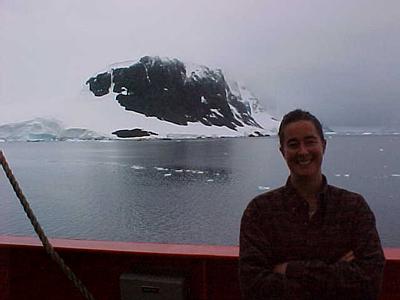
Joanna Hubbard in the waters of the Antarctic Peninsula.
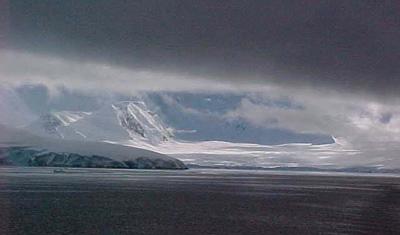
Mountains of the Antarctic Peninsula.

Anvers Island with Palmer Station in front of Marr Glacier.
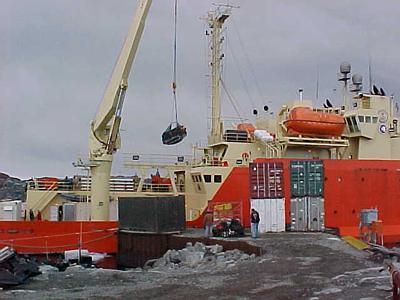
R.V. Gould off-loading cargo onto the Palmer dock.
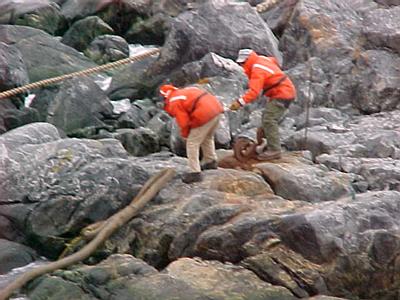
Line handlers pulling in a mooring rope.
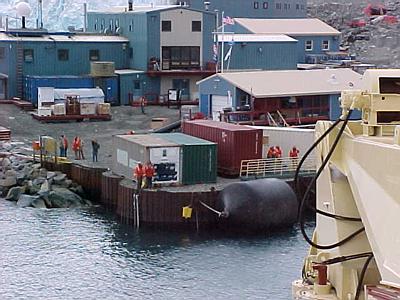
Approaching the dock on the R.V. Gould.

Contact the TEA in the field at
.
If you cannot connect through your browser, copy the
TEA's e-mail address in the "To:" line of
your favorite e-mail package.
|
